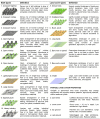Mapping Europe into local climate zones
- PMID: 31017939
- PMCID: PMC6481911
- DOI: 10.1371/journal.pone.0214474
Mapping Europe into local climate zones
Abstract
Cities are major drivers of environmental change at all scales and are especially at risk from the ensuing effects, which include poor air quality, flooding and heat waves. Typically, these issues are studied on a city-by-city basis owing to the spatial complexity of built landscapes, local topography and emission patterns. However, to ensure knowledge sharing and to integrate local-scale processes with regional and global scale modelling initiatives, there is a pressing need for a world-wide database on cities that is suited for environmental studies. In this paper we present a European database that has a particular focus on characterising urbanised landscapes. It has been derived using tools and techniques developed as part of the World Urban Database and Access Portal Tools (WUDAPT) project, which has the goal of acquiring and disseminating climate-relevant information on cities worldwide. The European map is the first major step toward creating a global database on cities that can be integrated with existing topographic and natural land-cover databases to support modelling initiatives.
Conflict of interest statement
The authors have declared that no competing interests exist.
Figures













References
-
- Baklanov A, Grimmond CSB, Carlson D, Terblanche D, Tang X, Bouchet V, et al. From urban meteorology, climate and environment research to integrated city services. Urban Climate. 2017;.
-
- Miralles DG, Teuling AJ, Heerwaarden CCV. Mega-heatwave temperatures due to combined soil desiccation and atmospheric heat accumulation. Nature Geoscience. 2014;7(5):345–349. 10.1038/ngeo2141 - DOI
Publication types
MeSH terms
Substances
LinkOut - more resources
Full Text Sources
Medical

